Project Management: New Technology Implementation at London Campus
VerifiedAdded on 2023/03/22
|11
|3737
|52
Report
AI Summary
This report provides a detailed project management plan for implementing new technologies in classrooms at the London Campus. It covers essential aspects such as project objectives, scope, deliverables, constraints, and assumptions. A stakeholder analysis identifies key individuals and their influence on the project. The report also evaluates potential risks, including change management, stakeholder attitudes, communication barriers, technical challenges, and quality concerns, along with mitigation strategies like risk acceptance, avoidance, limitation, and transference. A Gantt chart is included to illustrate the project timeline and resource allocation, ensuring effective monitoring and completion of project activities. The ultimate goal is to enhance the learning environment by integrating innovative technologies effectively.
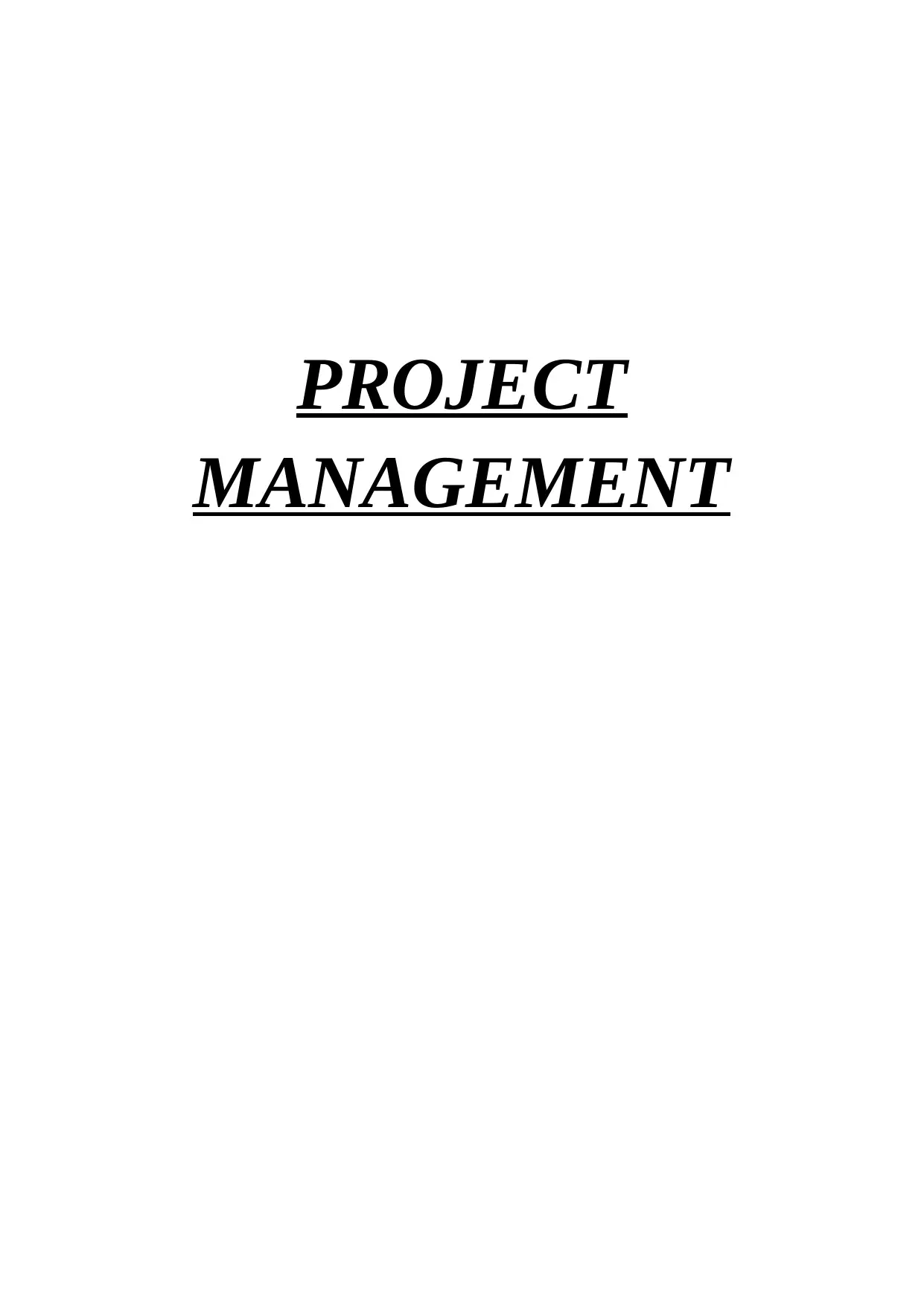
PROJECT
MANAGEMENT
MANAGEMENT
Paraphrase This Document
Need a fresh take? Get an instant paraphrase of this document with our AI Paraphraser

INTRODUCTION.........................................................................................................................................3
TASK..........................................................................................................................................................3
CONCLUSION.............................................................................................................................................9
REFERENCES............................................................................................................................................10
TASK..........................................................................................................................................................3
CONCLUSION.............................................................................................................................................9
REFERENCES............................................................................................................................................10
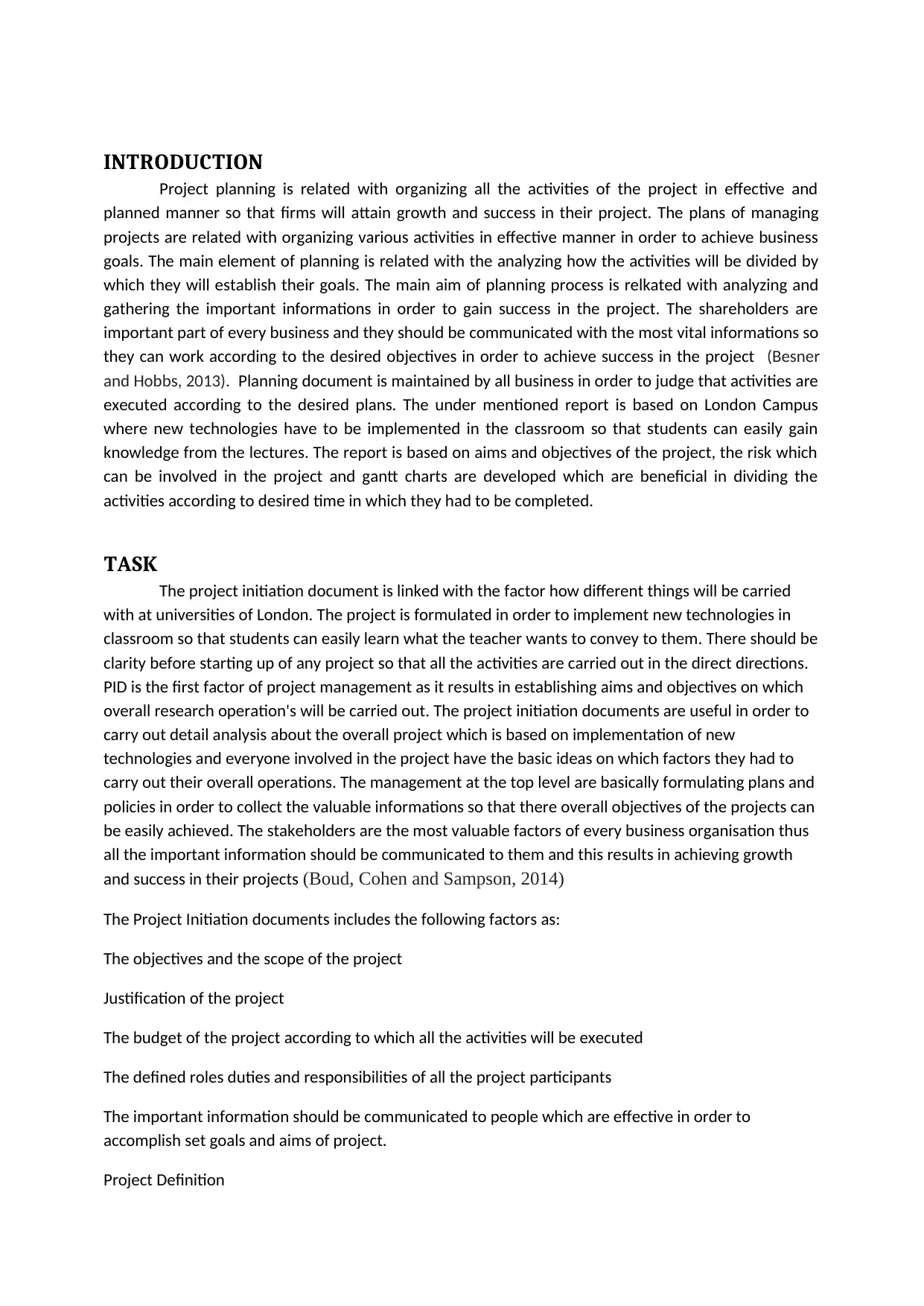
INTRODUCTION
Project planning is related with organizing all the activities of the project in effective and
planned manner so that firms will attain growth and success in their project. The plans of managing
projects are related with organizing various activities in effective manner in order to achieve business
goals. The main element of planning is related with the analyzing how the activities will be divided by
which they will establish their goals. The main aim of planning process is relkated with analyzing and
gathering the important informations in order to gain success in the project. The shareholders are
important part of every business and they should be communicated with the most vital informations so
they can work according to the desired objectives in order to achieve success in the project (Besner
and Hobbs, 2013). Planning document is maintained by all business in order to judge that activities are
executed according to the desired plans. The under mentioned report is based on London Campus
where new technologies have to be implemented in the classroom so that students can easily gain
knowledge from the lectures. The report is based on aims and objectives of the project, the risk which
can be involved in the project and gantt charts are developed which are beneficial in dividing the
activities according to desired time in which they had to be completed.
TASK
The project initiation document is linked with the factor how different things will be carried
with at universities of London. The project is formulated in order to implement new technologies in
classroom so that students can easily learn what the teacher wants to convey to them. There should be
clarity before starting up of any project so that all the activities are carried out in the direct directions.
PID is the first factor of project management as it results in establishing aims and objectives on which
overall research operation's will be carried out. The project initiation documents are useful in order to
carry out detail analysis about the overall project which is based on implementation of new
technologies and everyone involved in the project have the basic ideas on which factors they had to
carry out their overall operations. The management at the top level are basically formulating plans and
policies in order to collect the valuable informations so that there overall objectives of the projects can
be easily achieved. The stakeholders are the most valuable factors of every business organisation thus
all the important information should be communicated to them and this results in achieving growth
and success in their projects (Boud, Cohen and Sampson, 2014)
The Project Initiation documents includes the following factors as:
The objectives and the scope of the project
Justification of the project
The budget of the project according to which all the activities will be executed
The defined roles duties and responsibilities of all the project participants
The important information should be communicated to people which are effective in order to
accomplish set goals and aims of project.
Project Definition
Project planning is related with organizing all the activities of the project in effective and
planned manner so that firms will attain growth and success in their project. The plans of managing
projects are related with organizing various activities in effective manner in order to achieve business
goals. The main element of planning is related with the analyzing how the activities will be divided by
which they will establish their goals. The main aim of planning process is relkated with analyzing and
gathering the important informations in order to gain success in the project. The shareholders are
important part of every business and they should be communicated with the most vital informations so
they can work according to the desired objectives in order to achieve success in the project (Besner
and Hobbs, 2013). Planning document is maintained by all business in order to judge that activities are
executed according to the desired plans. The under mentioned report is based on London Campus
where new technologies have to be implemented in the classroom so that students can easily gain
knowledge from the lectures. The report is based on aims and objectives of the project, the risk which
can be involved in the project and gantt charts are developed which are beneficial in dividing the
activities according to desired time in which they had to be completed.
TASK
The project initiation document is linked with the factor how different things will be carried
with at universities of London. The project is formulated in order to implement new technologies in
classroom so that students can easily learn what the teacher wants to convey to them. There should be
clarity before starting up of any project so that all the activities are carried out in the direct directions.
PID is the first factor of project management as it results in establishing aims and objectives on which
overall research operation's will be carried out. The project initiation documents are useful in order to
carry out detail analysis about the overall project which is based on implementation of new
technologies and everyone involved in the project have the basic ideas on which factors they had to
carry out their overall operations. The management at the top level are basically formulating plans and
policies in order to collect the valuable informations so that there overall objectives of the projects can
be easily achieved. The stakeholders are the most valuable factors of every business organisation thus
all the important information should be communicated to them and this results in achieving growth
and success in their projects (Boud, Cohen and Sampson, 2014)
The Project Initiation documents includes the following factors as:
The objectives and the scope of the project
Justification of the project
The budget of the project according to which all the activities will be executed
The defined roles duties and responsibilities of all the project participants
The important information should be communicated to people which are effective in order to
accomplish set goals and aims of project.
Project Definition
⊘ This is a preview!⊘
Do you want full access?
Subscribe today to unlock all pages.

Trusted by 1+ million students worldwide
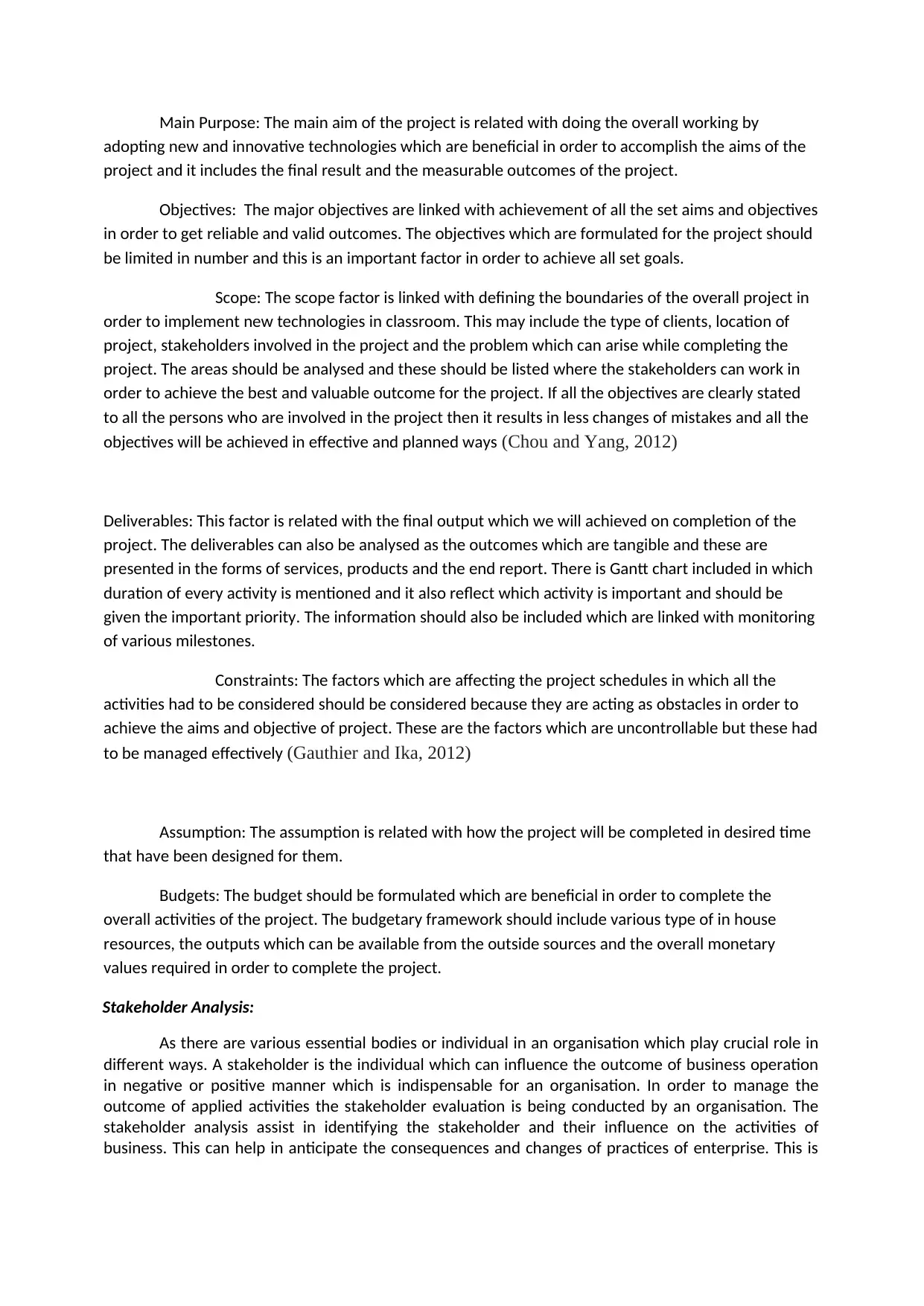
Main Purpose: The main aim of the project is related with doing the overall working by
adopting new and innovative technologies which are beneficial in order to accomplish the aims of the
project and it includes the final result and the measurable outcomes of the project.
Objectives: The major objectives are linked with achievement of all the set aims and objectives
in order to get reliable and valid outcomes. The objectives which are formulated for the project should
be limited in number and this is an important factor in order to achieve all set goals.
Scope: The scope factor is linked with defining the boundaries of the overall project in
order to implement new technologies in classroom. This may include the type of clients, location of
project, stakeholders involved in the project and the problem which can arise while completing the
project. The areas should be analysed and these should be listed where the stakeholders can work in
order to achieve the best and valuable outcome for the project. If all the objectives are clearly stated
to all the persons who are involved in the project then it results in less changes of mistakes and all the
objectives will be achieved in effective and planned ways (Chou and Yang, 2012)
Deliverables: This factor is related with the final output which we will achieved on completion of the
project. The deliverables can also be analysed as the outcomes which are tangible and these are
presented in the forms of services, products and the end report. There is Gantt chart included in which
duration of every activity is mentioned and it also reflect which activity is important and should be
given the important priority. The information should also be included which are linked with monitoring
of various milestones.
Constraints: The factors which are affecting the project schedules in which all the
activities had to be considered should be considered because they are acting as obstacles in order to
achieve the aims and objective of project. These are the factors which are uncontrollable but these had
to be managed effectively (Gauthier and Ika, 2012)
Assumption: The assumption is related with how the project will be completed in desired time
that have been designed for them.
Budgets: The budget should be formulated which are beneficial in order to complete the
overall activities of the project. The budgetary framework should include various type of in house
resources, the outputs which can be available from the outside sources and the overall monetary
values required in order to complete the project.
Stakeholder Analysis:
As there are various essential bodies or individual in an organisation which play crucial role in
different ways. A stakeholder is the individual which can influence the outcome of business operation
in negative or positive manner which is indispensable for an organisation. In order to manage the
outcome of applied activities the stakeholder evaluation is being conducted by an organisation. The
stakeholder analysis assist in identifying the stakeholder and their influence on the activities of
business. This can help in anticipate the consequences and changes of practices of enterprise. This is
adopting new and innovative technologies which are beneficial in order to accomplish the aims of the
project and it includes the final result and the measurable outcomes of the project.
Objectives: The major objectives are linked with achievement of all the set aims and objectives
in order to get reliable and valid outcomes. The objectives which are formulated for the project should
be limited in number and this is an important factor in order to achieve all set goals.
Scope: The scope factor is linked with defining the boundaries of the overall project in
order to implement new technologies in classroom. This may include the type of clients, location of
project, stakeholders involved in the project and the problem which can arise while completing the
project. The areas should be analysed and these should be listed where the stakeholders can work in
order to achieve the best and valuable outcome for the project. If all the objectives are clearly stated
to all the persons who are involved in the project then it results in less changes of mistakes and all the
objectives will be achieved in effective and planned ways (Chou and Yang, 2012)
Deliverables: This factor is related with the final output which we will achieved on completion of the
project. The deliverables can also be analysed as the outcomes which are tangible and these are
presented in the forms of services, products and the end report. There is Gantt chart included in which
duration of every activity is mentioned and it also reflect which activity is important and should be
given the important priority. The information should also be included which are linked with monitoring
of various milestones.
Constraints: The factors which are affecting the project schedules in which all the
activities had to be considered should be considered because they are acting as obstacles in order to
achieve the aims and objective of project. These are the factors which are uncontrollable but these had
to be managed effectively (Gauthier and Ika, 2012)
Assumption: The assumption is related with how the project will be completed in desired time
that have been designed for them.
Budgets: The budget should be formulated which are beneficial in order to complete the
overall activities of the project. The budgetary framework should include various type of in house
resources, the outputs which can be available from the outside sources and the overall monetary
values required in order to complete the project.
Stakeholder Analysis:
As there are various essential bodies or individual in an organisation which play crucial role in
different ways. A stakeholder is the individual which can influence the outcome of business operation
in negative or positive manner which is indispensable for an organisation. In order to manage the
outcome of applied activities the stakeholder evaluation is being conducted by an organisation. The
stakeholder analysis assist in identifying the stakeholder and their influence on the activities of
business. This can help in anticipate the consequences and changes of practices of enterprise. This is
Paraphrase This Document
Need a fresh take? Get an instant paraphrase of this document with our AI Paraphraser
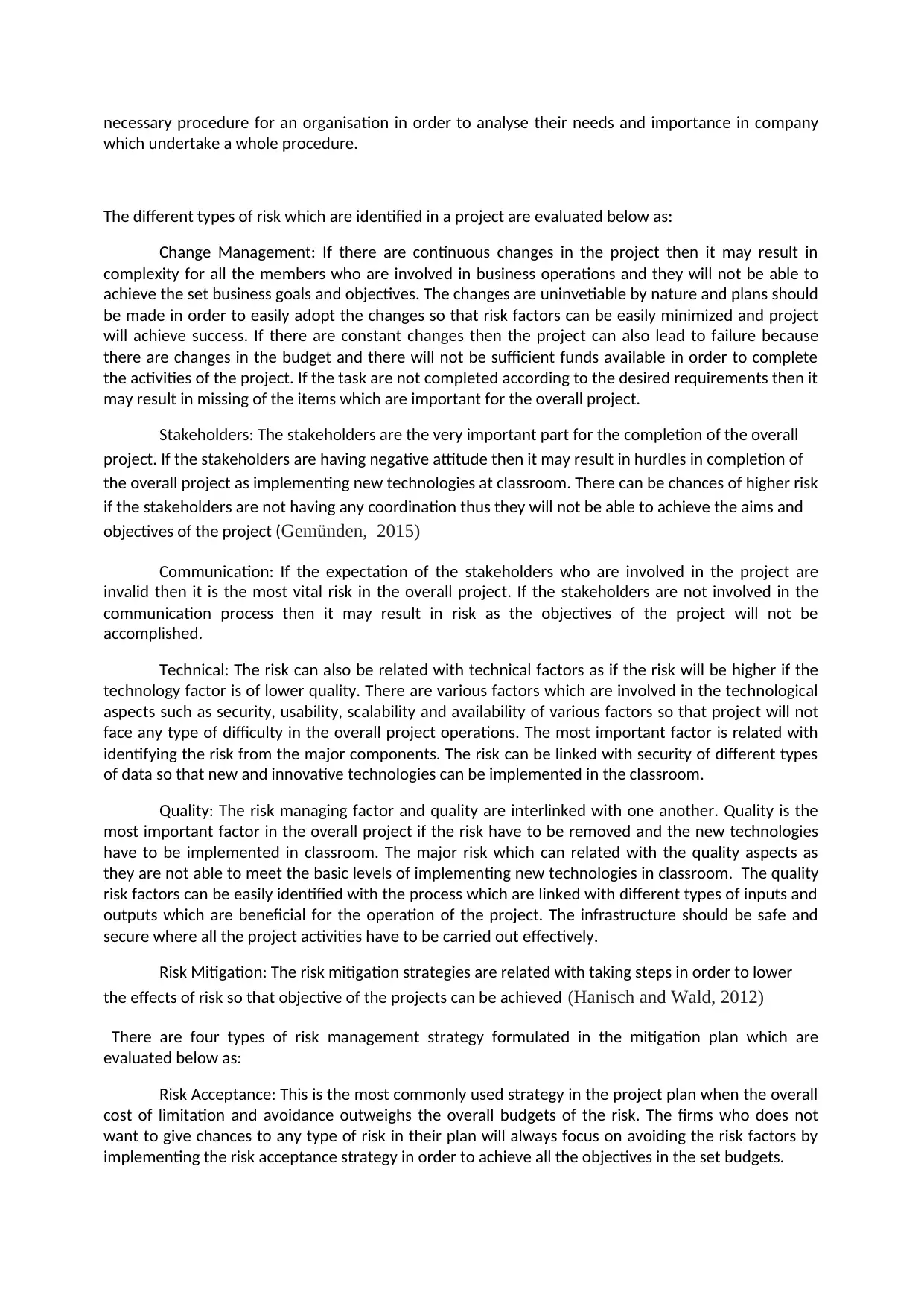
necessary procedure for an organisation in order to analyse their needs and importance in company
which undertake a whole procedure.
The different types of risk which are identified in a project are evaluated below as:
Change Management: If there are continuous changes in the project then it may result in
complexity for all the members who are involved in business operations and they will not be able to
achieve the set business goals and objectives. The changes are uninvetiable by nature and plans should
be made in order to easily adopt the changes so that risk factors can be easily minimized and project
will achieve success. If there are constant changes then the project can also lead to failure because
there are changes in the budget and there will not be sufficient funds available in order to complete
the activities of the project. If the task are not completed according to the desired requirements then it
may result in missing of the items which are important for the overall project.
Stakeholders: The stakeholders are the very important part for the completion of the overall
project. If the stakeholders are having negative attitude then it may result in hurdles in completion of
the overall project as implementing new technologies at classroom. There can be chances of higher risk
if the stakeholders are not having any coordination thus they will not be able to achieve the aims and
objectives of the project (Gemünden, 2015)
Communication: If the expectation of the stakeholders who are involved in the project are
invalid then it is the most vital risk in the overall project. If the stakeholders are not involved in the
communication process then it may result in risk as the objectives of the project will not be
accomplished.
Technical: The risk can also be related with technical factors as if the risk will be higher if the
technology factor is of lower quality. There are various factors which are involved in the technological
aspects such as security, usability, scalability and availability of various factors so that project will not
face any type of difficulty in the overall project operations. The most important factor is related with
identifying the risk from the major components. The risk can be linked with security of different types
of data so that new and innovative technologies can be implemented in the classroom.
Quality: The risk managing factor and quality are interlinked with one another. Quality is the
most important factor in the overall project if the risk have to be removed and the new technologies
have to be implemented in classroom. The major risk which can related with the quality aspects as
they are not able to meet the basic levels of implementing new technologies in classroom. The quality
risk factors can be easily identified with the process which are linked with different types of inputs and
outputs which are beneficial for the operation of the project. The infrastructure should be safe and
secure where all the project activities have to be carried out effectively.
Risk Mitigation: The risk mitigation strategies are related with taking steps in order to lower
the effects of risk so that objective of the projects can be achieved (Hanisch and Wald, 2012)
There are four types of risk management strategy formulated in the mitigation plan which are
evaluated below as:
Risk Acceptance: This is the most commonly used strategy in the project plan when the overall
cost of limitation and avoidance outweighs the overall budgets of the risk. The firms who does not
want to give chances to any type of risk in their plan will always focus on avoiding the risk factors by
implementing the risk acceptance strategy in order to achieve all the objectives in the set budgets.
which undertake a whole procedure.
The different types of risk which are identified in a project are evaluated below as:
Change Management: If there are continuous changes in the project then it may result in
complexity for all the members who are involved in business operations and they will not be able to
achieve the set business goals and objectives. The changes are uninvetiable by nature and plans should
be made in order to easily adopt the changes so that risk factors can be easily minimized and project
will achieve success. If there are constant changes then the project can also lead to failure because
there are changes in the budget and there will not be sufficient funds available in order to complete
the activities of the project. If the task are not completed according to the desired requirements then it
may result in missing of the items which are important for the overall project.
Stakeholders: The stakeholders are the very important part for the completion of the overall
project. If the stakeholders are having negative attitude then it may result in hurdles in completion of
the overall project as implementing new technologies at classroom. There can be chances of higher risk
if the stakeholders are not having any coordination thus they will not be able to achieve the aims and
objectives of the project (Gemünden, 2015)
Communication: If the expectation of the stakeholders who are involved in the project are
invalid then it is the most vital risk in the overall project. If the stakeholders are not involved in the
communication process then it may result in risk as the objectives of the project will not be
accomplished.
Technical: The risk can also be related with technical factors as if the risk will be higher if the
technology factor is of lower quality. There are various factors which are involved in the technological
aspects such as security, usability, scalability and availability of various factors so that project will not
face any type of difficulty in the overall project operations. The most important factor is related with
identifying the risk from the major components. The risk can be linked with security of different types
of data so that new and innovative technologies can be implemented in the classroom.
Quality: The risk managing factor and quality are interlinked with one another. Quality is the
most important factor in the overall project if the risk have to be removed and the new technologies
have to be implemented in classroom. The major risk which can related with the quality aspects as
they are not able to meet the basic levels of implementing new technologies in classroom. The quality
risk factors can be easily identified with the process which are linked with different types of inputs and
outputs which are beneficial for the operation of the project. The infrastructure should be safe and
secure where all the project activities have to be carried out effectively.
Risk Mitigation: The risk mitigation strategies are related with taking steps in order to lower
the effects of risk so that objective of the projects can be achieved (Hanisch and Wald, 2012)
There are four types of risk management strategy formulated in the mitigation plan which are
evaluated below as:
Risk Acceptance: This is the most commonly used strategy in the project plan when the overall
cost of limitation and avoidance outweighs the overall budgets of the risk. The firms who does not
want to give chances to any type of risk in their plan will always focus on avoiding the risk factors by
implementing the risk acceptance strategy in order to achieve all the objectives in the set budgets.
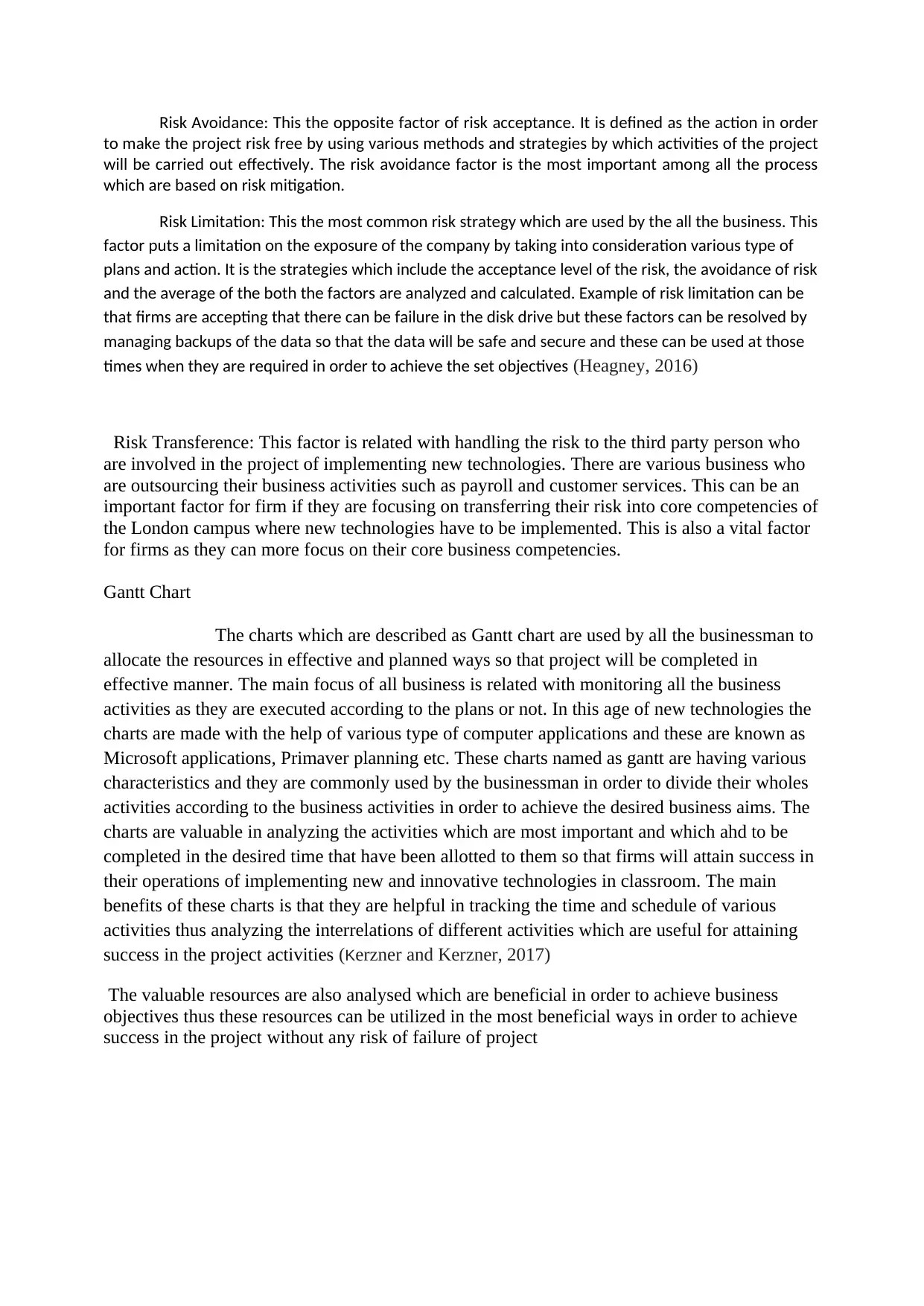
Risk Avoidance: This the opposite factor of risk acceptance. It is defined as the action in order
to make the project risk free by using various methods and strategies by which activities of the project
will be carried out effectively. The risk avoidance factor is the most important among all the process
which are based on risk mitigation.
Risk Limitation: This the most common risk strategy which are used by the all the business. This
factor puts a limitation on the exposure of the company by taking into consideration various type of
plans and action. It is the strategies which include the acceptance level of the risk, the avoidance of risk
and the average of the both the factors are analyzed and calculated. Example of risk limitation can be
that firms are accepting that there can be failure in the disk drive but these factors can be resolved by
managing backups of the data so that the data will be safe and secure and these can be used at those
times when they are required in order to achieve the set objectives (Heagney, 2016)
Risk Transference: This factor is related with handling the risk to the third party person who
are involved in the project of implementing new technologies. There are various business who
are outsourcing their business activities such as payroll and customer services. This can be an
important factor for firm if they are focusing on transferring their risk into core competencies of
the London campus where new technologies have to be implemented. This is also a vital factor
for firms as they can more focus on their core business competencies.
Gantt Chart
The charts which are described as Gantt chart are used by all the businessman to
allocate the resources in effective and planned ways so that project will be completed in
effective manner. The main focus of all business is related with monitoring all the business
activities as they are executed according to the plans or not. In this age of new technologies the
charts are made with the help of various type of computer applications and these are known as
Microsoft applications, Primaver planning etc. These charts named as gantt are having various
characteristics and they are commonly used by the businessman in order to divide their wholes
activities according to the business activities in order to achieve the desired business aims. The
charts are valuable in analyzing the activities which are most important and which ahd to be
completed in the desired time that have been allotted to them so that firms will attain success in
their operations of implementing new and innovative technologies in classroom. The main
benefits of these charts is that they are helpful in tracking the time and schedule of various
activities thus analyzing the interrelations of different activities which are useful for attaining
success in the project activities (Kerzner and Kerzner, 2017)
The valuable resources are also analysed which are beneficial in order to achieve business
objectives thus these resources can be utilized in the most beneficial ways in order to achieve
success in the project without any risk of failure of project
to make the project risk free by using various methods and strategies by which activities of the project
will be carried out effectively. The risk avoidance factor is the most important among all the process
which are based on risk mitigation.
Risk Limitation: This the most common risk strategy which are used by the all the business. This
factor puts a limitation on the exposure of the company by taking into consideration various type of
plans and action. It is the strategies which include the acceptance level of the risk, the avoidance of risk
and the average of the both the factors are analyzed and calculated. Example of risk limitation can be
that firms are accepting that there can be failure in the disk drive but these factors can be resolved by
managing backups of the data so that the data will be safe and secure and these can be used at those
times when they are required in order to achieve the set objectives (Heagney, 2016)
Risk Transference: This factor is related with handling the risk to the third party person who
are involved in the project of implementing new technologies. There are various business who
are outsourcing their business activities such as payroll and customer services. This can be an
important factor for firm if they are focusing on transferring their risk into core competencies of
the London campus where new technologies have to be implemented. This is also a vital factor
for firms as they can more focus on their core business competencies.
Gantt Chart
The charts which are described as Gantt chart are used by all the businessman to
allocate the resources in effective and planned ways so that project will be completed in
effective manner. The main focus of all business is related with monitoring all the business
activities as they are executed according to the plans or not. In this age of new technologies the
charts are made with the help of various type of computer applications and these are known as
Microsoft applications, Primaver planning etc. These charts named as gantt are having various
characteristics and they are commonly used by the businessman in order to divide their wholes
activities according to the business activities in order to achieve the desired business aims. The
charts are valuable in analyzing the activities which are most important and which ahd to be
completed in the desired time that have been allotted to them so that firms will attain success in
their operations of implementing new and innovative technologies in classroom. The main
benefits of these charts is that they are helpful in tracking the time and schedule of various
activities thus analyzing the interrelations of different activities which are useful for attaining
success in the project activities (Kerzner and Kerzner, 2017)
The valuable resources are also analysed which are beneficial in order to achieve business
objectives thus these resources can be utilized in the most beneficial ways in order to achieve
success in the project without any risk of failure of project
⊘ This is a preview!⊘
Do you want full access?
Subscribe today to unlock all pages.

Trusted by 1+ million students worldwide
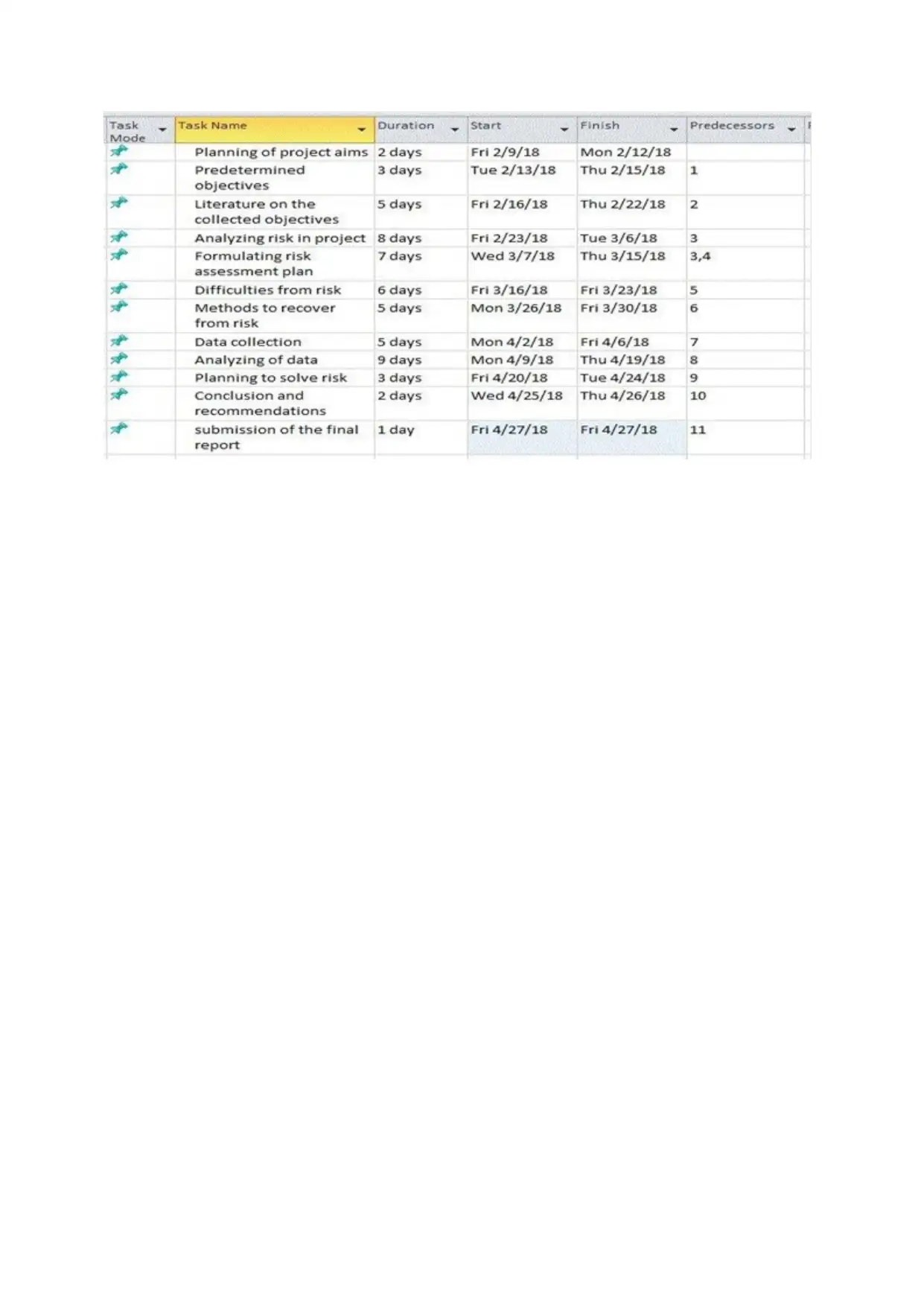
Paraphrase This Document
Need a fresh take? Get an instant paraphrase of this document with our AI Paraphraser
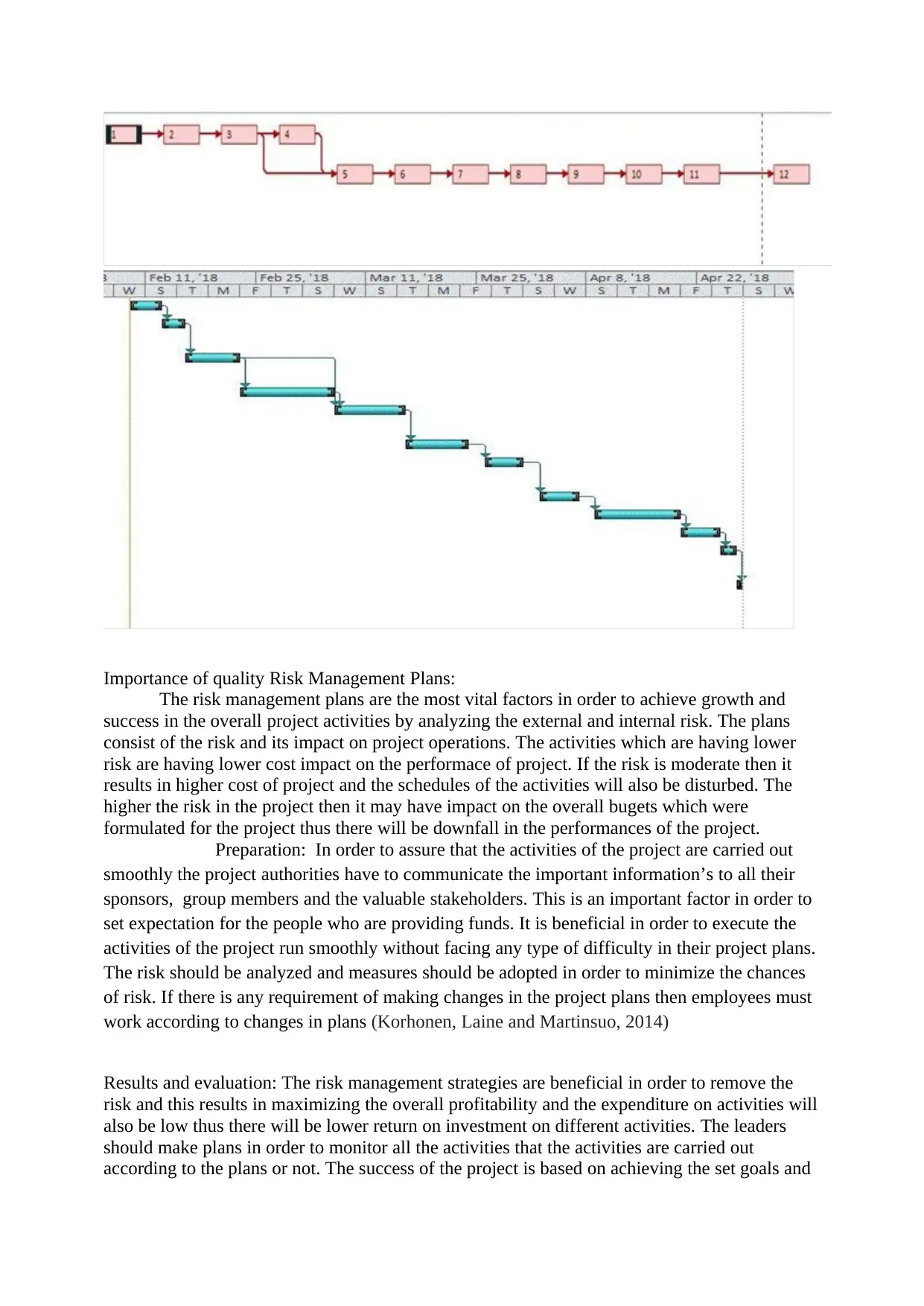
Importance of quality Risk Management Plans:
The risk management plans are the most vital factors in order to achieve growth and
success in the overall project activities by analyzing the external and internal risk. The plans
consist of the risk and its impact on project operations. The activities which are having lower
risk are having lower cost impact on the performace of project. If the risk is moderate then it
results in higher cost of project and the schedules of the activities will also be disturbed. The
higher the risk in the project then it may have impact on the overall bugets which were
formulated for the project thus there will be downfall in the performances of the project.
Preparation: In order to assure that the activities of the project are carried out
smoothly the project authorities have to communicate the important information’s to all their
sponsors, group members and the valuable stakeholders. This is an important factor in order to
set expectation for the people who are providing funds. It is beneficial in order to execute the
activities of the project run smoothly without facing any type of difficulty in their project plans.
The risk should be analyzed and measures should be adopted in order to minimize the chances
of risk. If there is any requirement of making changes in the project plans then employees must
work according to changes in plans (Korhonen, Laine and Martinsuo, 2014)
Results and evaluation: The risk management strategies are beneficial in order to remove the
risk and this results in maximizing the overall profitability and the expenditure on activities will
also be low thus there will be lower return on investment on different activities. The leaders
should make plans in order to monitor all the activities that the activities are carried out
according to the plans or not. The success of the project is based on achieving the set goals and
The risk management plans are the most vital factors in order to achieve growth and
success in the overall project activities by analyzing the external and internal risk. The plans
consist of the risk and its impact on project operations. The activities which are having lower
risk are having lower cost impact on the performace of project. If the risk is moderate then it
results in higher cost of project and the schedules of the activities will also be disturbed. The
higher the risk in the project then it may have impact on the overall bugets which were
formulated for the project thus there will be downfall in the performances of the project.
Preparation: In order to assure that the activities of the project are carried out
smoothly the project authorities have to communicate the important information’s to all their
sponsors, group members and the valuable stakeholders. This is an important factor in order to
set expectation for the people who are providing funds. It is beneficial in order to execute the
activities of the project run smoothly without facing any type of difficulty in their project plans.
The risk should be analyzed and measures should be adopted in order to minimize the chances
of risk. If there is any requirement of making changes in the project plans then employees must
work according to changes in plans (Korhonen, Laine and Martinsuo, 2014)
Results and evaluation: The risk management strategies are beneficial in order to remove the
risk and this results in maximizing the overall profitability and the expenditure on activities will
also be low thus there will be lower return on investment on different activities. The leaders
should make plans in order to monitor all the activities that the activities are carried out
according to the plans or not. The success of the project is based on achieving the set goals and
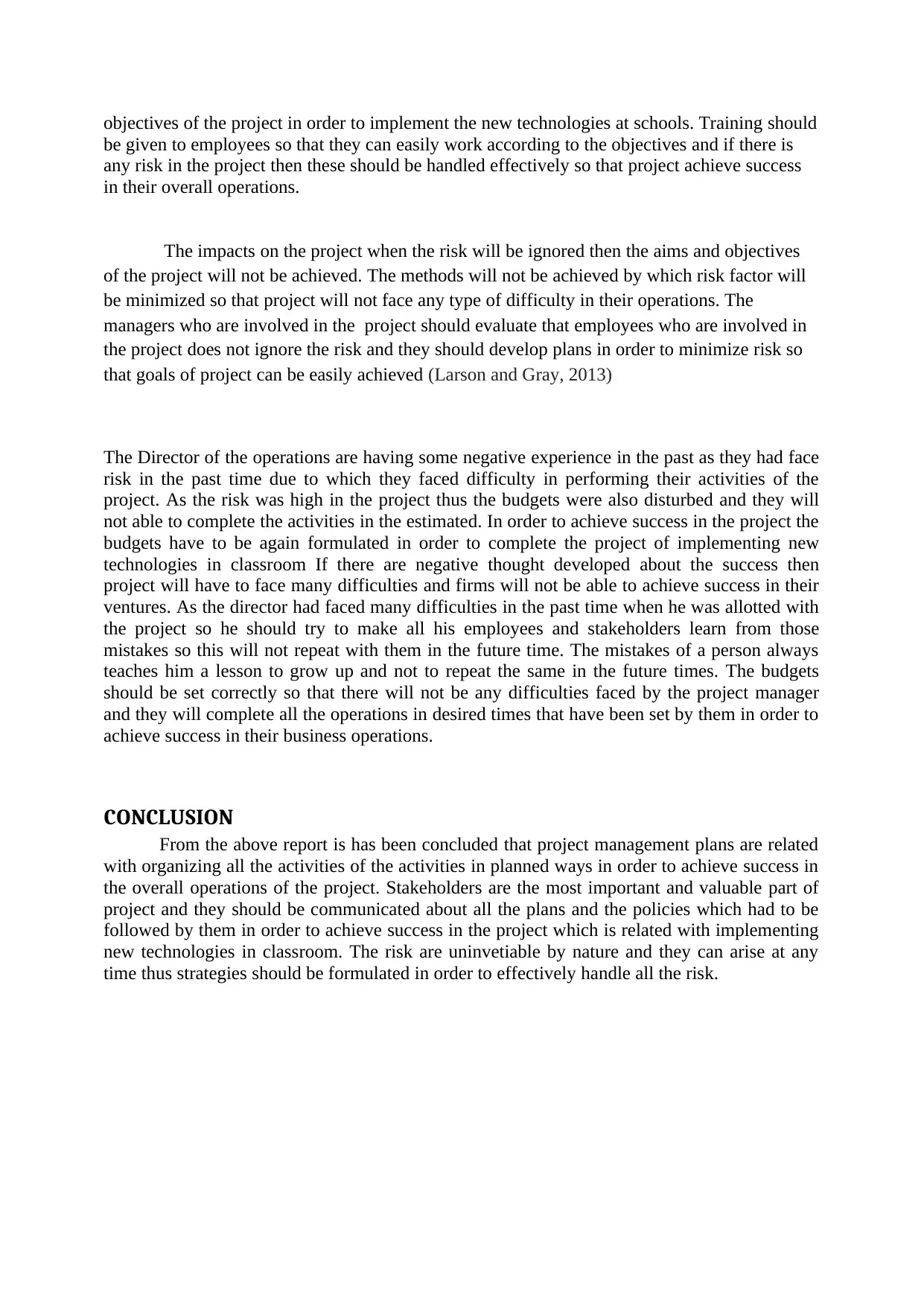
objectives of the project in order to implement the new technologies at schools. Training should
be given to employees so that they can easily work according to the objectives and if there is
any risk in the project then these should be handled effectively so that project achieve success
in their overall operations.
The impacts on the project when the risk will be ignored then the aims and objectives
of the project will not be achieved. The methods will not be achieved by which risk factor will
be minimized so that project will not face any type of difficulty in their operations. The
managers who are involved in the project should evaluate that employees who are involved in
the project does not ignore the risk and they should develop plans in order to minimize risk so
that goals of project can be easily achieved (Larson and Gray, 2013)
The Director of the operations are having some negative experience in the past as they had face
risk in the past time due to which they faced difficulty in performing their activities of the
project. As the risk was high in the project thus the budgets were also disturbed and they will
not able to complete the activities in the estimated. In order to achieve success in the project the
budgets have to be again formulated in order to complete the project of implementing new
technologies in classroom If there are negative thought developed about the success then
project will have to face many difficulties and firms will not be able to achieve success in their
ventures. As the director had faced many difficulties in the past time when he was allotted with
the project so he should try to make all his employees and stakeholders learn from those
mistakes so this will not repeat with them in the future time. The mistakes of a person always
teaches him a lesson to grow up and not to repeat the same in the future times. The budgets
should be set correctly so that there will not be any difficulties faced by the project manager
and they will complete all the operations in desired times that have been set by them in order to
achieve success in their business operations.
CONCLUSION
From the above report is has been concluded that project management plans are related
with organizing all the activities of the activities in planned ways in order to achieve success in
the overall operations of the project. Stakeholders are the most important and valuable part of
project and they should be communicated about all the plans and the policies which had to be
followed by them in order to achieve success in the project which is related with implementing
new technologies in classroom. The risk are uninvetiable by nature and they can arise at any
time thus strategies should be formulated in order to effectively handle all the risk.
be given to employees so that they can easily work according to the objectives and if there is
any risk in the project then these should be handled effectively so that project achieve success
in their overall operations.
The impacts on the project when the risk will be ignored then the aims and objectives
of the project will not be achieved. The methods will not be achieved by which risk factor will
be minimized so that project will not face any type of difficulty in their operations. The
managers who are involved in the project should evaluate that employees who are involved in
the project does not ignore the risk and they should develop plans in order to minimize risk so
that goals of project can be easily achieved (Larson and Gray, 2013)
The Director of the operations are having some negative experience in the past as they had face
risk in the past time due to which they faced difficulty in performing their activities of the
project. As the risk was high in the project thus the budgets were also disturbed and they will
not able to complete the activities in the estimated. In order to achieve success in the project the
budgets have to be again formulated in order to complete the project of implementing new
technologies in classroom If there are negative thought developed about the success then
project will have to face many difficulties and firms will not be able to achieve success in their
ventures. As the director had faced many difficulties in the past time when he was allotted with
the project so he should try to make all his employees and stakeholders learn from those
mistakes so this will not repeat with them in the future time. The mistakes of a person always
teaches him a lesson to grow up and not to repeat the same in the future times. The budgets
should be set correctly so that there will not be any difficulties faced by the project manager
and they will complete all the operations in desired times that have been set by them in order to
achieve success in their business operations.
CONCLUSION
From the above report is has been concluded that project management plans are related
with organizing all the activities of the activities in planned ways in order to achieve success in
the overall operations of the project. Stakeholders are the most important and valuable part of
project and they should be communicated about all the plans and the policies which had to be
followed by them in order to achieve success in the project which is related with implementing
new technologies in classroom. The risk are uninvetiable by nature and they can arise at any
time thus strategies should be formulated in order to effectively handle all the risk.
⊘ This is a preview!⊘
Do you want full access?
Subscribe today to unlock all pages.

Trusted by 1+ million students worldwide
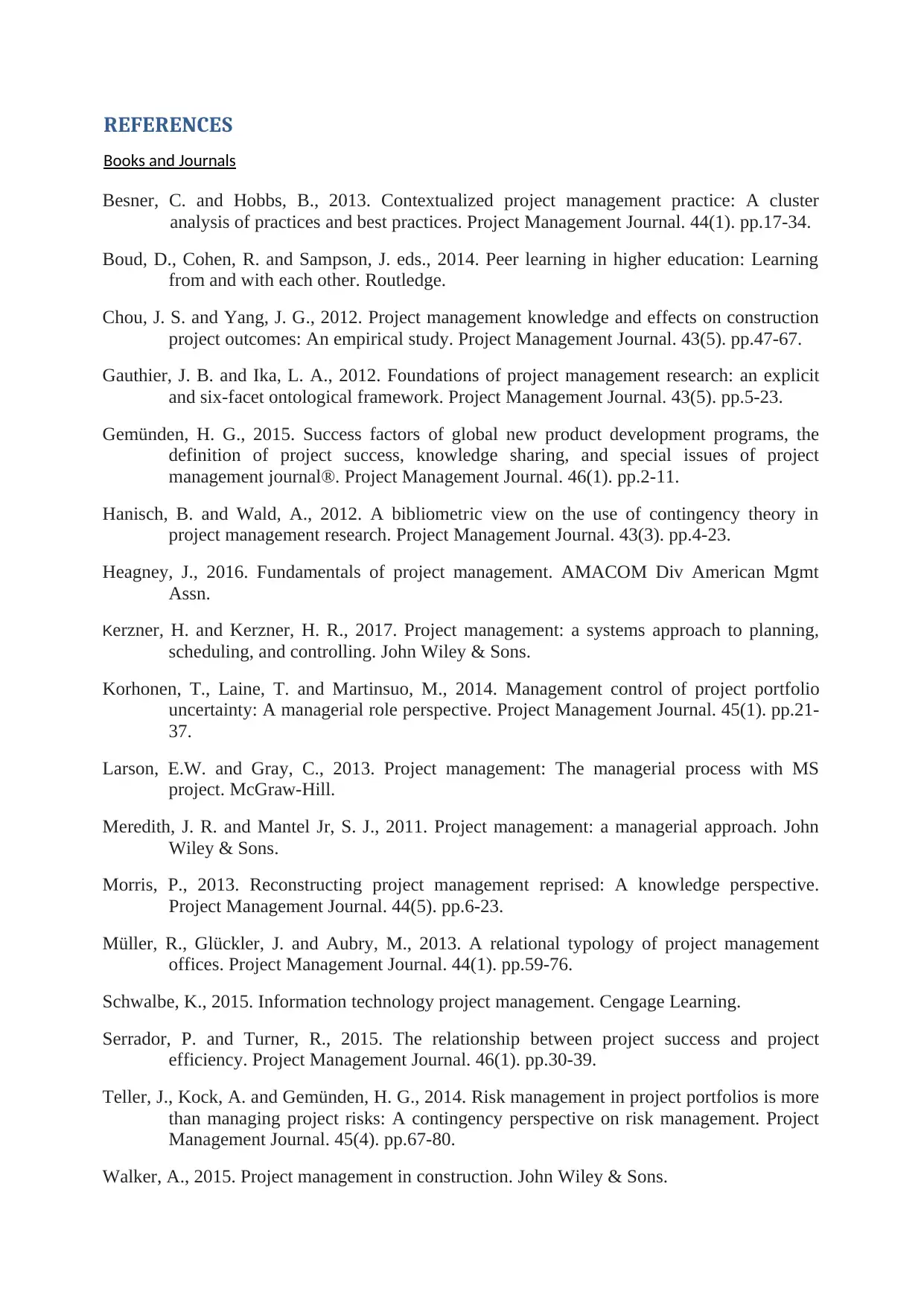
REFERENCES
Books and Journals
Besner, C. and Hobbs, B., 2013. Contextualized project management practice: A cluster
analysis of practices and best practices. Project Management Journal. 44(1). pp.17-34.
Boud, D., Cohen, R. and Sampson, J. eds., 2014. Peer learning in higher education: Learning
from and with each other. Routledge.
Chou, J. S. and Yang, J. G., 2012. Project management knowledge and effects on construction
project outcomes: An empirical study. Project Management Journal. 43(5). pp.47-67.
Gauthier, J. B. and Ika, L. A., 2012. Foundations of project management research: an explicit
and six‐facet ontological framework. Project Management Journal. 43(5). pp.5-23.
Gemünden, H. G., 2015. Success factors of global new product development programs, the
definition of project success, knowledge sharing, and special issues of project
management journal®. Project Management Journal. 46(1). pp.2-11.
Hanisch, B. and Wald, A., 2012. A bibliometric view on the use of contingency theory in
project management research. Project Management Journal. 43(3). pp.4-23.
Heagney, J., 2016. Fundamentals of project management. AMACOM Div American Mgmt
Assn.
Kerzner, H. and Kerzner, H. R., 2017. Project management: a systems approach to planning,
scheduling, and controlling. John Wiley & Sons.
Korhonen, T., Laine, T. and Martinsuo, M., 2014. Management control of project portfolio
uncertainty: A managerial role perspective. Project Management Journal. 45(1). pp.21-
37.
Larson, E.W. and Gray, C., 2013. Project management: The managerial process with MS
project. McGraw-Hill.
Meredith, J. R. and Mantel Jr, S. J., 2011. Project management: a managerial approach. John
Wiley & Sons.
Morris, P., 2013. Reconstructing project management reprised: A knowledge perspective.
Project Management Journal. 44(5). pp.6-23.
Müller, R., Glückler, J. and Aubry, M., 2013. A relational typology of project management
offices. Project Management Journal. 44(1). pp.59-76.
Schwalbe, K., 2015. Information technology project management. Cengage Learning.
Serrador, P. and Turner, R., 2015. The relationship between project success and project
efficiency. Project Management Journal. 46(1). pp.30-39.
Teller, J., Kock, A. and Gemünden, H. G., 2014. Risk management in project portfolios is more
than managing project risks: A contingency perspective on risk management. Project
Management Journal. 45(4). pp.67-80.
Walker, A., 2015. Project management in construction. John Wiley & Sons.
Books and Journals
Besner, C. and Hobbs, B., 2013. Contextualized project management practice: A cluster
analysis of practices and best practices. Project Management Journal. 44(1). pp.17-34.
Boud, D., Cohen, R. and Sampson, J. eds., 2014. Peer learning in higher education: Learning
from and with each other. Routledge.
Chou, J. S. and Yang, J. G., 2012. Project management knowledge and effects on construction
project outcomes: An empirical study. Project Management Journal. 43(5). pp.47-67.
Gauthier, J. B. and Ika, L. A., 2012. Foundations of project management research: an explicit
and six‐facet ontological framework. Project Management Journal. 43(5). pp.5-23.
Gemünden, H. G., 2015. Success factors of global new product development programs, the
definition of project success, knowledge sharing, and special issues of project
management journal®. Project Management Journal. 46(1). pp.2-11.
Hanisch, B. and Wald, A., 2012. A bibliometric view on the use of contingency theory in
project management research. Project Management Journal. 43(3). pp.4-23.
Heagney, J., 2016. Fundamentals of project management. AMACOM Div American Mgmt
Assn.
Kerzner, H. and Kerzner, H. R., 2017. Project management: a systems approach to planning,
scheduling, and controlling. John Wiley & Sons.
Korhonen, T., Laine, T. and Martinsuo, M., 2014. Management control of project portfolio
uncertainty: A managerial role perspective. Project Management Journal. 45(1). pp.21-
37.
Larson, E.W. and Gray, C., 2013. Project management: The managerial process with MS
project. McGraw-Hill.
Meredith, J. R. and Mantel Jr, S. J., 2011. Project management: a managerial approach. John
Wiley & Sons.
Morris, P., 2013. Reconstructing project management reprised: A knowledge perspective.
Project Management Journal. 44(5). pp.6-23.
Müller, R., Glückler, J. and Aubry, M., 2013. A relational typology of project management
offices. Project Management Journal. 44(1). pp.59-76.
Schwalbe, K., 2015. Information technology project management. Cengage Learning.
Serrador, P. and Turner, R., 2015. The relationship between project success and project
efficiency. Project Management Journal. 46(1). pp.30-39.
Teller, J., Kock, A. and Gemünden, H. G., 2014. Risk management in project portfolios is more
than managing project risks: A contingency perspective on risk management. Project
Management Journal. 45(4). pp.67-80.
Walker, A., 2015. Project management in construction. John Wiley & Sons.
Paraphrase This Document
Need a fresh take? Get an instant paraphrase of this document with our AI Paraphraser
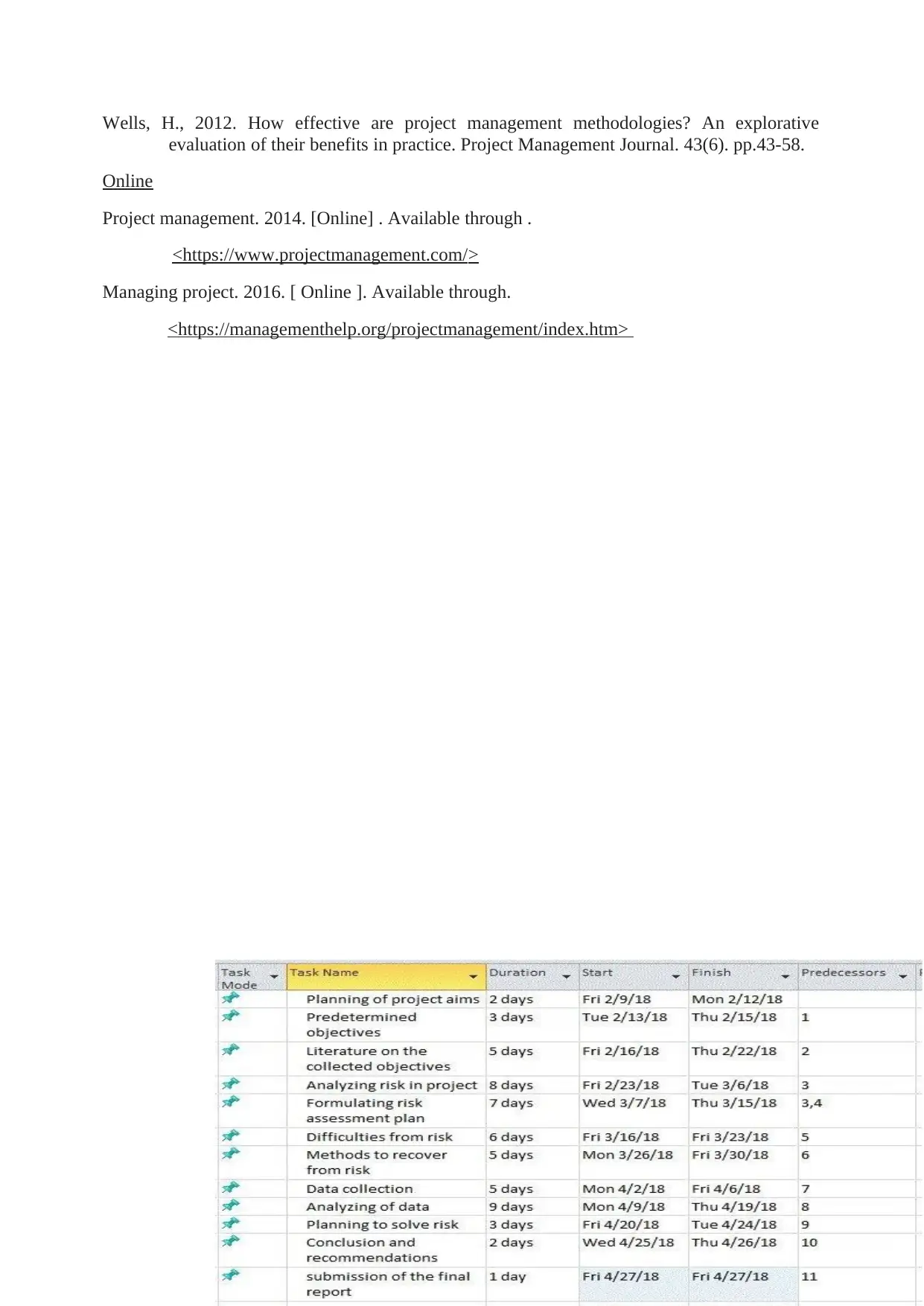
Wells, H., 2012. How effective are project management methodologies? An explorative
evaluation of their benefits in practice. Project Management Journal. 43(6). pp.43-58.
Online
Project management. 2014. [Online] . Available through .
<https://www.projectmanagement.com/>
Managing project. 2016. [ Online ]. Available through.
<https://managementhelp.org/projectmanagement/index.htm>
evaluation of their benefits in practice. Project Management Journal. 43(6). pp.43-58.
Online
Project management. 2014. [Online] . Available through .
<https://www.projectmanagement.com/>
Managing project. 2016. [ Online ]. Available through.
<https://managementhelp.org/projectmanagement/index.htm>
1 out of 11
Related Documents
Your All-in-One AI-Powered Toolkit for Academic Success.
+13062052269
info@desklib.com
Available 24*7 on WhatsApp / Email
![[object Object]](/_next/static/media/star-bottom.7253800d.svg)
Unlock your academic potential
Copyright © 2020–2025 A2Z Services. All Rights Reserved. Developed and managed by ZUCOL.





